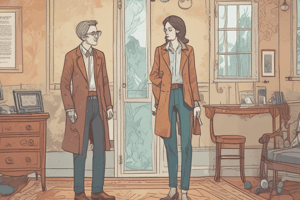Podcast
Questions and Answers
What societal structure primarily influences the gender roles in Romeo and Juliet?
What societal structure primarily influences the gender roles in Romeo and Juliet?
- Utopian society
- Patriarchal society (correct)
- Democratic society
- Matriarchal society
Men in Romeo and Juliet are shown to have no social rules to follow.
Men in Romeo and Juliet are shown to have no social rules to follow.
False (B)
What is the primary reason for the ongoing feud between the Montagues and Capulets?
What is the primary reason for the ongoing feud between the Montagues and Capulets?
An ancient grudge, the cause of which is never revealed.
The character of ________ expresses traditional beliefs of masculinity in Act 1, Scene 1.
The character of ________ expresses traditional beliefs of masculinity in Act 1, Scene 1.
Match the following characters with their expressions of masculinity:
Match the following characters with their expressions of masculinity:
Which of these actions demonstrates the theme of masculinity and pride?
Which of these actions demonstrates the theme of masculinity and pride?
The play suggests that male characters would rather be perceived as cowards than engage in conflict.
The play suggests that male characters would rather be perceived as cowards than engage in conflict.
How does Shakespeare use the opening scene to establish the theme of masculinity?
How does Shakespeare use the opening scene to establish the theme of masculinity?
What is one of the ways masculinity is exemplified in Act 1 Scene 1?
What is one of the ways masculinity is exemplified in Act 1 Scene 1?
Romeo's characterization in the play aligns with traditional notions of masculinity.
Romeo's characterization in the play aligns with traditional notions of masculinity.
What does the term 'Petrarchan lover' refer to in the context of Romeo?
What does the term 'Petrarchan lover' refer to in the context of Romeo?
Romeo blames his _____ on Juliet, stating that her beauty has made him soft.
Romeo blames his _____ on Juliet, stating that her beauty has made him soft.
Match the male characters to their traits or actions:
Match the male characters to their traits or actions:
How does Romeo's emotional state change throughout the play?
How does Romeo's emotional state change throughout the play?
The Friar's statement about Romeo's tears reflects a supportive perception of masculinity.
The Friar's statement about Romeo's tears reflects a supportive perception of masculinity.
Describe how Romeo's actions in the early part of the play differ from traditional male behavior.
Describe how Romeo's actions in the early part of the play differ from traditional male behavior.
What does Lord Capulet believe about his authority in the family?
What does Lord Capulet believe about his authority in the family?
Juliet feels empowered to choose her own husband throughout the play.
Juliet feels empowered to choose her own husband throughout the play.
What does Lady Capulet express fear about concerning Juliet?
What does Lady Capulet express fear about concerning Juliet?
Mercutio describes Rosaline’s body using a list of her physical features, which reflects his tendency to view women as __________.
Mercutio describes Rosaline’s body using a list of her physical features, which reflects his tendency to view women as __________.
Match the character with their perspective on women's roles in the play:
Match the character with their perspective on women's roles in the play:
How does Lord Capulet react when Juliet refuses to marry Paris?
How does Lord Capulet react when Juliet refuses to marry Paris?
Juliet's nurse promotes independence and self-empowerment for women.
Juliet's nurse promotes independence and self-empowerment for women.
At what age does Lady Capulet suggest Juliet should start thinking about marriage?
At what age does Lady Capulet suggest Juliet should start thinking about marriage?
Flashcards
Gender Roles in Romeo and Juliet
Gender Roles in Romeo and Juliet
Gender is a crucial theme in Romeo and Juliet, shaping characters and their development. However, it can also cause conflict as characters don't always adhere to traditional gender roles.
Gender Roles for Men
Gender Roles for Men
Despite being set in a patriarchal society oppressive to women, men also faced strict social rules and expectations. This highlights that gender constraints were present for both sexes.
Masculinity in Romeo and Juliet
Masculinity in Romeo and Juliet
Masculinity is a dominant theme in Romeo and Juliet, influencing how male characters interact. It often drives their actions towards each other and women.
Masculinity and the Feud
Masculinity and the Feud
Signup and view all the flashcards
Opening Scene and Masculinity
Opening Scene and Masculinity
Signup and view all the flashcards
Sampson and Traditional Masculinity
Sampson and Traditional Masculinity
Signup and view all the flashcards
Masculinity's Impact
Masculinity's Impact
Signup and view all the flashcards
Gender Roles and Conflict
Gender Roles and Conflict
Signup and view all the flashcards
Petrarchan Lover
Petrarchan Lover
Signup and view all the flashcards
Hypermasculinity
Hypermasculinity
Signup and view all the flashcards
Romeo's Subverted Masculinity
Romeo's Subverted Masculinity
Signup and view all the flashcards
Romeo's Feminine Traits
Romeo's Feminine Traits
Signup and view all the flashcards
Societal Expectations of Masculinity
Societal Expectations of Masculinity
Signup and view all the flashcards
Romeo's Self-Perception
Romeo's Self-Perception
Signup and view all the flashcards
Romeo's Struggle with Masculinity
Romeo's Struggle with Masculinity
Signup and view all the flashcards
Capulet's Authority
Capulet's Authority
Signup and view all the flashcards
Capulet's Demeaning Language
Capulet's Demeaning Language
Signup and view all the flashcards
Lady Capulet's Marriage Concern
Lady Capulet's Marriage Concern
Signup and view all the flashcards
Nurse's Sexual Humor
Nurse's Sexual Humor
Signup and view all the flashcards
Mercutio's Rosaline Description
Mercutio's Rosaline Description
Signup and view all the flashcards
Friar's Love Observation
Friar's Love Observation
Signup and view all the flashcards
Wife and Mother Role
Wife and Mother Role
Signup and view all the flashcards
Sexual Objectification
Sexual Objectification
Signup and view all the flashcards
Study Notes
AQA English Literature GCSE: Romeo and Juliet - Gender Roles
- Gender is a significant theme in Romeo and Juliet, influencing character development and conflict. Characters do not always adhere to traditional gender roles within a patriarchal society.
- Masculinity is often linked to violence and destructive behaviour, particularly among male characters. This is evident from the opening scene involving conflict and pride.
- Hegemonic masculinity is a key concept, which suggests male dominance is established through the submission of women and also the suppression of opposing views. Sampson exemplifies this through his violent actions.
- Men in Elizabethan times were expected to be violent and aggressive. This is reflected in the play's characters.
- Romeo's masculinity is portrayed differently; initially he is lovesick and his behaviour is described as effeminate. This contrasted with traditional masculine standards. His personality shifts after external events.
- Women in the play are frequently viewed as sexual objects, influenced by cultural norms of the time. They are often seen as passive and dependent on men.
- Juliet actively seeks agency by challenging the expectations placed upon women, demonstrating assertive behaviour in courtship.
- Marriage is a significant aspect of a woman's role; in Elizabethan society marriage was a way to cement alliances between families. This is portrayed in the play's events.
- Juliet displays agency and challenges the expectations placed upon women, by actively participating in her courtship.
- Women are expected to be passive and subservient to men. The play challenges this through Juliet.
- Shakespeare's depiction of characters displays both traditional and unconventional portrayals of gender.
The Role of Women
- Elizabethan women were expected to marry and become mothers, often as part of family arrangements.
- Women's roles are frequently framed within the context of marriage.
- Within the play, women's behaviour may seem to contradict or conform to traditional expectations.
- The female characters' agency and defiance of these roles can be examined for their implications.
- Women are viewed by men as sexual objects in the play.
The Role of Men
- Elizabethan men were expected to be the head of the household and show dominance.
- Masculinity often manifests itself through violence and aggression, and men are frequently portrayed as the initiators of conflict.
- The play depicts men exhibiting a mix of conventional and unconventional masculine traits.
- The concept of hegemonic masculinity is an important consideration here.
- Men are portrayed to be in a state of conflict both with themselves and towards each other.
Courtship and Marriage
- Courtship and marriage are often depicted as instruments of social and political maneuvering, reflecting the societal expectations of the Elizabethan era.
- Juliet actively participates in the process of courtship as opposed to a more passive role. Courtship had changed between men and women.
- Romeo and Juliet challenged this, with Juliet having agency and engaging actively in the process.
Studying That Suits You
Use AI to generate personalized quizzes and flashcards to suit your learning preferences.




